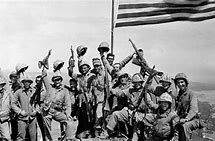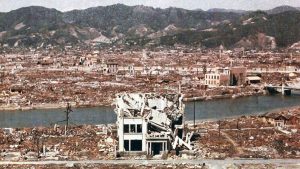Here is a course of events that started in the ’40s and changed the world order.
The World process in a big context 
A closer look at the past events of the 1940s shows almost a temporal symmetry: in the first five years, from 1940 to May 1945 (in Asia until the beginning of September), there was war, while the second half of the decade was dominated by peace, more precisely, remained: full of attempts to keep the world at peace. That is the unusual symmetry: five years of war, five years of peace.
The limitation that the “second” five years had been filled with attempts to keep the world at peace is necessary because the years from 1945 to 1950 entered the memory of contemporaries less than the early years of peace than the years of the so-called cold war, the years of severe tensions in relations between the United States and the Soviet Union. In the area of the economy, it is the years of the beginning of an unprecedented boom.
One could also call them the years of the beginning of the triumphal march of the engine with all its revolutionary influences, or the years of the beginning of new dimensions in the world in which the continents quickly came closer, and also in the cultural field the limitation of the national standards and Conditions were partially suppressed.
This general, global upturn in the second half of the 1940s was not only a blatant contrast to the terrible conflict during the war years; it already indicated a contradiction. By this allusion, I mean the contradiction between the results of technical and natural economic progress, which have broken all previous dimensions and transformed the world into one, as well as the ongoing political turmoil of the world, and it’s a threat to all possible manifestations of violence.
From European to World War
Let us first follow the abrupt events in the five war years of the decade from a European and worldwide aspect. Hitler’s Armies flooded into Denmark and Norway and occupied both countries. A few weeks later, on the 10th, they attacked France, which was sitting behind a fortress wall, which was named after its builder and was considered to be the insurmountable Maginot Line, in the meantime the Germans attacked and raided Holland, Belgian and Luxembourg. The immobility of the “drôle de Guerre” had turned into the stormy force of the motorized war of aggression on land and in the air. Within a few weeks, France surrendered and then, under Marshal Pétain, the legendary former defender of Verdun Fortress in the First World War, formed a new government, after an armistice with Hitler was signed on June 22.
French General de Gaulle, meanwhile, escaped to England, where Winston Churchill had become Prime Minister. And he didn’t think of making peace with Hitler. Mussolini, the dictator of fascism from Italy, panicked that he might be late in the redistribution of the world, therefore quickly declared war on collapsing France and annexed areas around Nizza. Except for the neutral states of Switzerland, Greece, Turkey, and Spain (which were heavily depressed after the civil war), Hitler now controlled the European continent, all the way to the Atlantic Ocean. The resistance was embodied by Britain, on its own, in Great Britain. Hitler, whose navy was inferior to the British, tried to seize England with all of his strong air force in September. But the Brits, equipped with all of the most modern radar equipment, were able to withstand the Germans from the air and repel them. They won the Battle of Britain. On their side standing, the states of the British commonwealth and, in terms of support with money and war material, the United States of America.
The next chapter followed, which is conditioned by the principle that successful, violent folding of powers stimulates the hunger for more power. The war spreads rapidly, first in Europe, then beyond Europe. When Italy entered the war, it also spread to Africa. The Britons drove the Italians out of their possession in the Libyan Cyrenaica, in spring 1941 from Eritrea and afterward from Abyssinia.
The losses in Libya forced Mussolini to ask Hitler for help in fighting the English in Africa. But soon, in October, the Italians brought the war into southern Europe: they attacked Greece, but soon got stuck there as well, so German troops once again had to come to their aid. In April 1941 Hitler’s troops attacked Yugoslavia and occupied it. There, the war was then called the “Kleinkrieg” (small war).
Then, on the night of June 21-22, 1941 Hitler gave the order to attack the Soviet Union. This marked the German Reich, being in a two-front war, which Hitler himself described in his book “Mein Kampf” as the worst strategic mistake of imperial Germany including the First World War.
By late autumn 1941, the German armies managed to advance in a stormy, aggressive way, right up to Moscow. But they didn’t get any further.
That success prompted the officer-ruling Camilla in Japan, who had already embroiled the country in a war with China and had also sealed a three-power pack with Hitler and Mussolini in 1940, in the early morning of December 7, 1941, to attack and destroy the American naval base in the port of Pearl Harbor on the island Hawaii with submarines, and from the air, inflicting massive destruction and loss of lives.
Overnight the United States was drawn into the war. Hitler, Mussolini, and the Japanese campaigners stood now at the peak of their power. The Allies, i.e. Great Britain and the states of its Commonwealth, the United States of Amerika, the General de Gaulle entrusted, free French and colonial associations and the other European states at war with Germany were the challenging ones and were on the defensive front. The situation lasted until the summer of 1942. Then the turn began with the penultimate section of the Second World War.
The Turn
The turn came thanks to the British’s inner resilience and determined resistance and the brutal challenge of the Americans. Until the (video) Pearl Harbor attack, the idea of America entering the war had by no means been very popular. The nefarious blow of the Japanese changed the mood quickly and thoroughly. America unfolded its huge potential for wartimes. It mobilized people, materials, and skills. The war economy pounded out of the ground was sufficient to equip armies within a few months, to build up the air force and the fleet according to the latest achievements, and also to a large extent to supply weapons and ammunition to the Allies, to the Britons, the French and above the Persian Gulf, to the Soviet Union.
Then, however, the counter-strikes began in all locations. In the summer of 1942, the Americans won the naval and air battle in the Coral Sea and Midway Islands, causing heavy losses to the Japanese. At the end of November, the Russians were able to encircle several army units near Stalingrad. The terrible Winterschlacht (Winterbattle) ended in early February 1943 with the death of 146,000 and the capture of 91,000 German soldiers – an event that triggered a shock in Germany.
In May 1943
the German-Italian army group capitulated at El-Alamein. Over 200,000 men were captured here. The transition from Africa to Sicily stood now open for the Brits and Americans.
The situation had now turned into its opposite, and the Americans were gradually recovering areas in the Pacific Ocean that the Japanese had occupied. In the European theater of war, the Germans retreated. In the south, the Allies seized Italy. Fascism collapsed on July 25, 1943, Mussolini was arrested and later executed
The new government declared Italy to have left the war on September 8, and from autumn onwards the Russians slowly but surely pushed the Germans back to the borders of the Reich. The western Allies landed on June 6, 1944, on the French Channel coast. At the same time, the devastating air raids on the German cities, and the centers of their war productions, began. An assassination attempt against Hitler on July 20, 1944, attempted by conspiratorial officers and underground opposition politicians, failed and was cruelly avenged by Hitler afterward.
From the winter of 1944, the end of the war in Europe was only a matter of time. The war was now at the borders of Germany and had already exceeded some of them.
The Collapse 
The last chapter followed in Europe, characterized by the state of the agony of the Third Reich. Hitler committed suicide in Berlin on April 30, 1945, while the final battles with the invaded Russians took place in the city. On May 8, 1945, Grand Admiral Dönitz, who had been appointed by Hitler as his successor, signed the unconditional surrender. The fighting in Asia continued until the Americans dropped atomic bombs on two Japanese cities, Hiroshima and Nagasaki, in early August. The terrible effects of these bombs led to the unconditional surrender of all Japanese troops on September 2, 1945 – after the European war, the world war had finally come to an end.
The Calamity of Power
The second world war was a major political and economic disaster. Do catastrophes such as war make sense? Today we hardly ask this question anymore when it comes to natural disasters: natural disasters are caused by forces that are beyond human influence.
In such disasters as water shortages, fires, earthquakes, hurricanes, or tornadoes, people see the punishing hand of God and they accepted it as a warning.
Could you imagine what this world be like if the combined forces of the Allies wouldn’t remove Hitler from power?!
Read part two of World changing Events here
Recent Posts
Ulrich’s GAProductions
The Dinosaur Eye – Wall Art
Get your Wall Picture here Read More
Hot Chocolates Restaurant and Nite Club
All your Traveling needs here at Amazon Read More
My Cosmopolitan Magazine modeling Days😁
Ulrich’s Miami Mob ordeal Read More
Ulrich’s Hot Chocolates, Fort Lauderdale, Florida, 1997 – 2001
Hike to Lake Tremorgio, Ticino, Switzerland
Daniel Humm is revolutionizing 3-Star Cuisine
This is how the first vegan menu tastes in “Eleven Madison Park” in New York... Read More
Swiss Travel Soothing Music Video
Ulrich’s Guadalajara & Mexico City Experience
Chef Ulrich in Action in Guadalajara, Mexico My first visit to Mexico was with my... Read More
Chef UlrichK on Selkirk CH.13 Cooking Show
My awkward Brandy bottle pop! The video is 16 min. long – Video is 37... Read More
Ulrich in the Dominican Republic
In 1987 I arrived in Santo Domingo to work on the re-opening of the new... Read More
Ulrich’s Miami Mob ordeal
As a Swiss chef, I took the opportunity to go and see the world, that... Read More
Exciting Swiss Family Koepf Hike to 2300 m
The Bristen (3073m) is a mountain in the Canton of Uri, Central Switzerland. ... Read More
Around Monte Baldo, Italy
On my recent visit to Verona, I came across these amazing places; situated in the... Read More
Subscribe here
Click here to Subscribe Read More
Aquaria, Thermal Waters of Sirmione
The Uniquelness of our Thermal Water Click here to visit the website The... Read More
In a MOOD for Sushi?
I am not a fan of raw fish, I like my fish cooked, especially knowing... Read More

